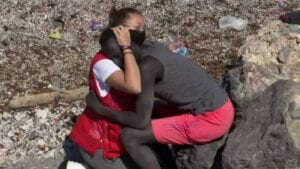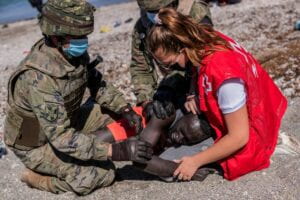Graciela Blandon /
Asociación Pro Derechos Humanos de Andalucía (APDHA) /
Cadiz, Spain /
To wrap up my time in Spain, I’d like to revisit the questions I posed myself at the beginning of the summer and answer myself directly to the best of my ability.
- How do border populaces define their own sovereignty?
Periphery communities assert their self-determination in little ways, day by day. I’ve found that culture is of immense political value, as it contributes to the creation of shared identity and oppositional consciousness among populaces
- What is the role of human rights organizations in integrating the migrant as one of the first points of contact?
At APDHA, what I anticipated to be integration projects were called talleres de sensibilizacion or “sensibilization” projects. Interns put together powerpoints on Spanish culture, history, and legislative processes to present to newcomers. These workshops were not meant to infringe upon any individual’s sense of identity, nor did they have an external political agenda. They were meant to be welcoming. We talked about Paella, Flamenco, and the role of the monarchy, for example. For many migrants, a warm welcome, a person of contact, and accessible resources went a long way. The sensibilization projects attempted to imbue migration with the sense of excitement and normalcy any other traveler would have.
On the other hand, an image of a Senegalese migrant embracing a 20 year old Red Cross volunteer after disembarking on the shores of Ceuta haunted me. At its core, the viral image evoked the same message of welcome and safety we attempted to bring to the workshops. But I couldn’t help but dwell on the picture, the reports that followed it, and the sensation it caused online. Luna Reyes was hailed as a hero, sparking the hashtag #GraciasLuna. Online discourse also soon centered her as the aggrieved- she was being intensely harassed by rightists for the act. The association of white femininity with the redeeming purity of Europe did not escape me and was obviously present in headlines reporting the incident (I am also, once again, reminded of Alan Kurdi and the instrumentality of the innocent migrant). The semiotics of the image made me ponder the dynamics present in the sensibilization workshops. I could have easily been in Reyes’s place. I saw a teacher-student relationship established between myself, an American white woman with a few months’ worth of knowledge about Spain, and those who were meant to be “sensibilized ” toward Europe.
- What identities are created or destroyed due to living in a peripheral community and how are they affected by national identity, Europeanisation, and the idea of citizenship?
An immense amount of academia has been produced on this topic. A Spanish uncle I had lunch with recently made these works superfluous by summing them all up: “The worst enemies of the Spanish are the Spanish.” I can mention that in Andalucía, I’ve found regional identity to be far more prevalent than allegiance towards Europe or Spain, as the autonomy of the region is inscribed in the constitution. Thus, the negotiation of identity is a daily task for the Spanish.
But more pressing than all these theoretical inquiries were the questions that had kept me up at night prior to my departure from home. Would my Spanish be good enough? What if I didn’t make any friends? How could I live so far from my family and friends for so long? The answer to all these questions was: I’m capable of so much more than I thought. It’s impossible to capture my summer internship experience in a mere four blog posts. Similarly, it was impossible to feel ready to leave Spain after a mere ten weeks. For every catastrophe I anticipated and for every lonely moment that passed, I found days filled with adventure and beauty. I’m eternally grateful and more determined than ever to globalize my studies.





